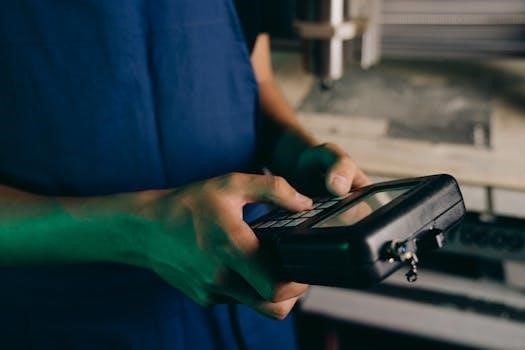The Jandy AquaLink RS system offers advanced control for pool and spa equipment. It provides an intuitive interface for managing various pool functions, including temperature, lighting, and filtration. The system allows users to conveniently control pool and spa settings.
Overview of AquaLink RS Systems
The AquaLink RS systems are designed to provide comprehensive control over pool and spa equipment. These systems offer a range of options for managing various functions, from basic on/off switching to advanced scheduling and automation. AquaLink RS systems come in different configurations, including options for pool-only, spa-only, and combined pool/spa setups. Each system includes a power center with relays, temperature sensors, and a control panel. Some systems also include valve actuators (JVAs) for more complex setups. The systems utilize a user-friendly interface and allow for indoor or wireless control. The AquaLink RS platform enables users to easily manage their pool and spa’s key functions. Multiple control panels can be supported within a single system, enhancing flexibility and convenience. AquaLink RS systems prioritize ease of use while providing powerful control over pool environments. These systems are designed to make pool and spa management simple for homeowners.
AquaLink RS Control Panel Types
AquaLink RS systems offer two primary control panel types⁚ the All Button Control Panel and the OneTouch Control Panel. Each panel provides distinct features for system operation and management.
All Button Control Panel Features
The All Button Control Panel is designed for intuitive and user-friendly operation, allowing easy adjustment of settings like temperature, lighting, and filtration schedules. This panel provides direct access to various pool and spa functions through dedicated buttons. The system includes the necessary relays for equipment control, ensuring seamless management of pool systems. It is a core component of the Jandy AquaLink RS systems, offering straightforward control over pool and spa automation. This panel also allows for the programming of equipment schedules. All Button panels generally come with the power center PCB, and temperature sensors. This type of panel is designed for ease of use, making it accessible for all users. It enables users to easily turn equipment on or off and to display what is going on in the system.
OneTouch Control Panel Operation
The OneTouch Control Panel simplifies pool and spa management with easy-to-use controls. It allows users to quickly turn equipment on or off, and the system supports automatic operation through programmed schedules. The panel is designed for use with Jandy AquaLink RS systems, including pool/spa combinations and dual equipment setups. It provides a user-friendly interface for adjusting settings and accessing various pool functions. This panel comes with a power center PCB and temperature sensors, ensuring seamless integration. The OneTouch panel simplifies access to equipment with one-touch operation. The system can be controlled in multiple ways. This panel is designed for ease of use, and allows access to all settings.

Installation and Setup
Installation of the AquaLink RS system involves unpacking all components and wiring the power center. Specific package contents vary. It is important to follow the appropriate wiring guide for proper setup.
AquaLink RS System Package Contents
The specific contents of an AquaLink RS system package will depend on the chosen configuration, such as whether it’s for a pool-only, spa-only, or combination system. All AquaLink RS systems include the required number of 3HP relays. A typical package contains the main control panel, which could be an All Button or OneTouch panel, along with the power center PCB. Two temperature sensors are also standard. Combination pool/spa systems will also include two JVAs. Furthermore, additional relays are provided as needed. Certain dual equipment setups may even include three temperature sensors, and the power center itself depends on the control panel type. Ensure all components are present before initiating installation. Refer to the installation manual for a detailed list of components included with your specific system.
Wiring and Power Center Installation
When installing an AquaLink RS system, wiring and power center installation are crucial steps. Begin by carefully routing wires from the heat pump control panel through the designated conduit, typically on the heat pump’s right side. Connect the heat pump to a suitable power source, ensuring all connections are secure. The power center PCB is a central component, requiring proper wiring according to the system’s specifications. Securely mount the power center and ensure all wiring is neatly organized and properly connected. After completing wiring, install the panels over the wiring compartments, and always keep the power center door closed. Consult the installation manual for precise wiring diagrams and safety guidelines to avoid electrical hazards. Accurate installation is essential for the reliable operation of your AquaLink RS system.

Operation and Programming
The AquaLink RS system allows users to turn equipment on and off. It also enables programming of schedules for automatic operation. The control panel provides a way to manage these functions.
Basic Functions of the Control Panel
The Jandy AquaLink RS control panel provides users with intuitive access to core pool and spa functions. Primarily, it allows for the manual activation and deactivation of various pieces of equipment, such as pumps, heaters, and lighting systems. This can be accomplished through simple button presses or selections on the panel interface, providing immediate control over your pool environment. Moreover, the panel displays crucial system information, including time, date, current water temperature, and the operational status of connected equipment. This immediate feedback keeps users informed about their pool system at all times. The basic functionality also extends to setting equipment to run automatically based on programmed schedules, ensuring convenient and energy-efficient operation of the pool and spa. This essential function lays the foundation for more advanced programming.
Programming Equipment Schedules
The Jandy AquaLink RS control panel allows users to program specific schedules for their pool and spa equipment, providing automated control. Through the panel’s intuitive interface, users can set equipment to turn on or off at particular times throughout the day or week. This feature allows for customized operation based on individual needs and preferences, optimizing energy consumption and convenience. Users can program various functions like pump operation, heater activation, and lighting schedules, enabling a fully automated pool or spa experience. This scheduling capability ensures that the system runs efficiently, maintaining water quality and desired temperatures without manual intervention. Programming is facilitated through the panel’s menu options.

Advanced Features and Troubleshooting
The AquaLink RS system supports multiple control panels, enhancing accessibility. Troubleshooting resources, including manuals, are available for resolving operational issues. These features ensure seamless control and maintenance.
Multiple Control Panel Support
The Jandy AquaLink RS system is designed to accommodate multiple indoor control panels, allowing for convenient access and management of pool and spa functions from various locations within a property. Specifically, the system can support up to four indoor control panels, providing enhanced flexibility and accessibility for users. This feature ensures that users can conveniently adjust settings, monitor equipment status, and manage pool and spa operations without being confined to a single control point. This capability is particularly beneficial in larger properties or when multiple individuals need to control the system. The ability to install several panels provides convenience and ensures full control.
Troubleshooting and Manuals
For troubleshooting the Jandy AquaLink RS system, users can refer to the comprehensive manuals available online, which include detailed instructions for diagnosing and resolving common issues. These manuals provide valuable information regarding potential problems and offer step-by-step guides for resolving them. The troubleshooting sections cover a wide range of issues, from basic operational problems to more complex system malfunctions. Users should consult the manuals to identify the root cause of the problem before attempting any repairs. Additionally, it is important to consult the user manual to understand the proper functions of the control panel and ensure safe operation. These manuals are essential resources for maintaining the system.

Additional Resources
Users can find manuals and support for Jandy AquaLink systems on the manufacturer’s website and other online resources. These materials provide essential information for proper operation and maintenance.
Where to Find Manuals and Support
Locating the correct manuals and support for your Jandy AquaLink control panel is crucial for proper operation and troubleshooting. The primary source for manuals is the official Zodiac Pool Systems website, where you can often find downloadable PDFs of installation guides, owner’s manuals, and troubleshooting documents. These documents contain detailed instructions on system setup, operation, and maintenance. Additionally, many online retailers specializing in pool equipment often have links to these manuals on their product pages.
For technical assistance, you can contact Zodiac Pool Systems directly through their customer service phone line or email. Many online forums dedicated to pool equipment and maintenance also have active communities where users share their experiences and provide helpful advice. Lastly, local pool professionals and service companies are another resource for expert support and information regarding your Jandy AquaLink system. Remember to have your model number ready when seeking assistance for a quicker resolution.




Leave a Reply
You must be logged in to post a comment.